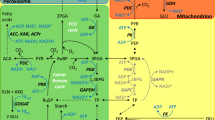Abstract
Recycling of carbon in the oxidative pentose phosphate pathway (OPPP) of intact pea root plastids has been studied. The synthesis of dihydroxyacetone phosphate (DHAP) and evolution of CO2 was followed in relation to nitrite reduction. A close coupling was observed between all three measured fluxes which were linear for up to 60 min and dependent upon the integrity of the plastids. However, the quantitative relationship between 1-14CO2 evolution from glucose 6-phosphate and nitrite reduction varied with available hexose phosphate concentration. When 10 mM glucose 6-phosphate was supplied to intact plastids a stoichiometry of 1.35 was observed between 14CO2 evolution and nitrite reduction. As exogenous glucose 6-phosphate was decreased this value fell, becoming 0.47 in the presence of 0.2 mM glucose 6-phosphate, indicative of considerable recycling of carbon. This conclusion was reinforced when using [2-14C]glucose-6-phosphate. The measured release of 2-14CO2 was consistent with the data for 1-14CO2, suggesting complete recycling of carbon in the OPPP. Ribose 5-phosphate was also able to support nitrite reduction and DHAP production. A stoichiometry of 2 NO −2 reduced: 1 DHAP synthesised was observed at concentrations of 1 mM ribose 5-phosphate or less. At concentrations of ribose 5-phosphate greater than 1 mM this stoichiometry was lost as a result of enhanced DHAP synthesis without further increase in nitrite reduction. It is suggested that this decoupling from nitrite reduction is a function of excess substrate entering directly into the non-oxidative reactions of the OPPP, and may be useful when the demand for OPPP products is not linked to the demand for reductant. The significance of recycling in the OPPP is discussed in relation to the coordination of nitrate assimilation with carbohydrate oxidation in roots and with the utilisation of carbohydrate by other pathways within plastids.
Similar content being viewed by others
Abbreviations
- DHAP:
-
dihydroxyacetone phosphate
- Fru6P:
-
fructose 6-phosphate
- Glc6P:
-
glucose 6-phosphate
- OPPP:
-
oxidative pentose phosphate pathway
- R5P:
-
ribose 5-phosphate
References
ap Rees T (1985) The organisation of glycolysis and the oxidative pentose phosphate pathway in plants. In: Douce, R, Day DA (eds) Encyclopedia of plant physiology, vol. 18. Springer-Verlag, Berlin, pp 391–417
Borchert S, Grosse H, Heldt HW (1989) Specific transport of inorganic phosphate, glucose 6-phosphate, dihydroxyacetone phosphate and 3-phosphoglycerate into amyloplasts from pea roots. FEBS Lett 253: 183–186
Borchert S, Harborth J, Schunemann D, Hoferichter P, Heldt HW (1993) Studies of the enzymatic capacities and transport properties of pea root plastids. Plant Physiol 101: 303–312
Bowsher CG, Hucklesby DP, Emes MJ (1989) Nitrite reduction and carbohydrate metabolism in plastids purified from roots of Pisum sativum L. Planta 177: 359–366
Bowsher CG, Boulton EL, Rose J, Nayagam S, Emes MJ (1992) Reductant for glutamate synthase is generated by the oxidative pentose phosphate pathway in non-photosynthetic plastids. Plant J 2: 893–898
Bradford MM (1976) A rapid and sensitive method for the quantitation of microgram quantities of protein utilizing the principle of protein-dye binding. Anal Biochem 72: 248–254
Butt VS, Beevers H (1961) The regulation of pathways of glucose catabolism in maize roots. Biochem J 171: 519–526
Coates SA, ap Rees T (1993) Carbohydrate oxidation by leucoplasts from suspension cultures of soybean (Glycine max L.). Planta 198: 516–521
Emes MJ, England S (1986) Purification of plastids from higher plant roots. Planta 168: 161–166
Emes MJ, Fowler MW (1979a) The intracellular location of the enzymes of nitrate assimilation in the apices of seedling pea roots. Planta 144: 249–253
Emes MJ, Fowler MW (1979b) Intracellular interactions between the pathways of carbohydrate oxidation and nitrate assimilation in plants roots. Planta 145: 287–292
Emes MJ, Fowler MW (1983) The supply of reducing power for nitrite reduction in plastids of seedling pea roots (Pisum sativum L.). Planta 158: 97–102
Hill L, Smith AM (1991) Evidence that glucose 6-phosphate is imported as the substrate for starch synthesis by the plastids of developing pea embryos. Planta 185: 91–96
Frehner M, Pozueta-Romera J, Akazawa T (1990) Enzyme sets of glycolysis, gluconeogenesis and oxidative pentose phosphate pathway, are not complete in non-green, highly purified amyloplasts of sycamore (Acer pseudoplatanus L.) cell suspension cultures. Plant Physiol 94: 538–544
Keeling PL, Wood JR, Tyson RH, Bridges IG (1988) Starch biosynthesis in developing wheat grain. Plant Physiol 87: 311–319
Kleppinger Sparace KF, Stahl RJ, Sparace SA (1992) Energy requirements for fatty acid and glycerolipid biosynthesis from acetate by isolated pea root plastids. Plant Physiol 98: 723–727
Tetlow IJ, Blissett KJ, Emes MJ (1994) Starch synthesis and carbohydrate oxidation in amyloplasts from developing wheat endosperm. Planta 194: 454–460
Trimming BA, Emes MJ (1993) Glycolytic enzymes in non-photosynthetic plastids of pea (Pisum sativum L.) roots. Planta 190: 439–445
Tyson RH, ap Rees T (1988) starch synthesis by isolated amyloplasts from wheat endosperm. Planta 175: 33–38
Tyson RH, ap Rees T (1991) Starch synthesis by isolated amyloplasts from wheat endosperm. Planta 189: 597–600
Author information
Authors and Affiliations
Additional information
We wish to thank M. Burrell (Advanced Technologies (Cambridge) Ltd., UK) for helpful discussions during the preparation of this manuscript. This work was supported by a grant from the Biotechnology and Biological Sciences Research Council. We thank Miss Angela Parker for typing the manuscript. Dr. C.G. Bowsher grati fully acknowledges receipt of the Royal Society Pickering Researc Fellowship.
Rights and permissions
About this article
Cite this article
Hartwell, J., Bowsher, C.G. & Emes, M.J. Recycling of carbon in the oxidative pentose phosphate pathway in non-photosynthetic plastids. Planta 200, 107–112 (1996). https://doi.org/10.1007/BF00196656
Received:
Accepted:
Issue Date:
DOI: https://doi.org/10.1007/BF00196656




